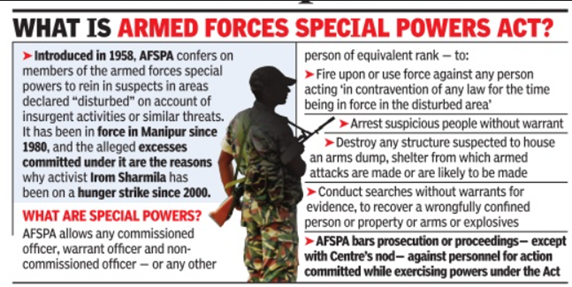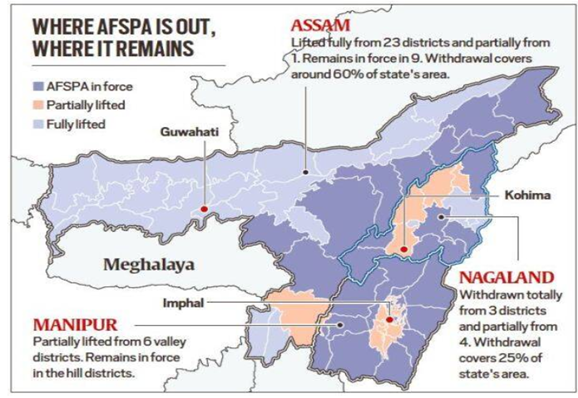Questioning AFSPA’s Necessity.
Relevance
- GS 3: Various Security Forces and Agencies and their Mandate.
- Tags: #AFSPA #InternalSecurity #ManipurVoilence #UPSC #CurrentAffairs.
Why in the News?
The extension of the Armed Forces (Special Powers) Act (AFSPA) in Manipur, excluding the Imphal Valley, raises questions about its necessity amidst ongoing ethnic conflict. The government’s approach should focus on reconciliation between communities to prevent further deterioration.
What is AFSPA?
AFSPA is a legal framework granting special powers to armed forces operating in “disturbed areas” to maintain law and order.
- Objective: It is intended to equip the military with the authority to tackle insurgency and maintain public order effectively.
AFSPA: A Historical Overview
Pre-Independence AFSPA Origin
- The roots of the Armed Forces (Special Powers) Act (AFSPA) can be traced back to the era of British colonial rule in India.
- During the Quit India Movement of 1942, a period of heightened civil unrest and protests against British rule, the colonial authorities resorted to repressive measures to quell dissent.
- Emergency Provisions: In response to the civil disobedience and protests, the British enacted emergency provisions that bestowed special powers upon the armed forces to combat what they perceived as subversion.
Post-Independence AFSPA Extension
- In 1958, the Armed Forces (Special Powers) Bill was introduced in the Indian Parliament to address security challenges in the northeastern states. It later became the Armed Forces (Special Powers) Act, 1958.
- Objective: AFSPA was designed to equip the armed forces with special powers to deal with insurgency and maintain public order in regions facing armed conflict and disturbances
AFSPA Extension
- Nagaland (1958): AFSPA was extended to Nagaland in response to insurgency by Naga National Council (NNC).
- Manipur (1980): The law was extended to Manipur in response to growing insurgency.
- Jammu and Kashmir (1990): AFSPA was implemented in Jammu and Kashmir amidst heightened militancy.
- Assam (1990): In response to the insurgency by the United Liberation Front of Assam (ULFA).
- Arunachal Pradesh (1990): In response to the insurgency by the National Socialist Council of Nagaland (NSCN-K).
- Meghalaya (1992): In response to the insurgency by the Garo National Liberation Army (GNLA) and other militant groups.
- Tripura (1997): In response to the insurgency by the National Liberation Front of Tripura (NLFT).
Provisions of AFSPA
Definitions and Applicability
- Section 2: Defines key terms, including “armed forces,” “disturbed area,” and “unlawful assembly.”
- Section 3: Empowers the Central Government, Governor of State or Administrator of Union Territory to declare areas as “disturbed” if they are facing insurgent activities, terrorist threats, or the general law and order situation.
Powers of the Armed Forces
- Section 4: Grants armed forces personnel the power to make arrests, search premises, and even use force, including causing death, against armed or potentially dangerous individuals.
- Section 5: Provides legal immunity to armed forces personnel for their actions, unless the use of force is in violation of the Act.
Arrests and Detention
- Section 6: Authorizes the arrest and detention of individuals without a warrant, especially if there are reasonable grounds to suspect their involvement in unlawful activities.
- Section 7: Allows detainees to be held without formal charges for an initial period of 24 hours, which can be extended to 90 days with permission.
Search and Seizure
- Section 4A: Introduced in certain states, it grants additional powers for search and seizure operations.
- Section 5A: Provides authority for the destruction of structures used for shelter by armed groups.
Legal Protections
- Section 6A: Mandates that any legal proceeding against armed forces personnel requires prior permission from the Central Government.
- Section 7: Establishes a Review board to examine cases of arrests and detentions.
Consequences of AFSPA
- Section 8: Bars civil courts from intervening in matters related to actions taken under AFSPA.
- Section 9: Provides safeguards against prosecutions without prior sanction.
Reports on Actions Taken
- Section 8: Whenever any armed forces personnel exercise the powers conferred by AFSPA, a Report detailing the circumstances must be sent to the state government.
- Public Knowledge: The report is to be placed before the state legislature, ensuring public knowledge of the actions taken.
Committees Associated with AFSPA
Jeevan Reddy Committee (2005)
- Formed to review AFSPA’s necessity.
- Recommendations: Suggested repeal, calling it “a symbol of oppression.”
Santosh Hegde Committee (2013)
- Objective: Investigate allegations of extra-judicial killings in Manipur.
- Findings: Raised concerns about human rights violations and recommended actions against perpetrators.
AFSPA Review Committee (2020)
- Objective: To assess the possibility of AFSPA’s partial revocation in Jammu and Kashmir.
- Outcome: Led to the partial withdrawal of AFSPA in specific areas of the union territory.
Impact of AFSPA
| Positive Impact of AFSPA
|
Negative Impact of AFSPA
|
| Counter-Insurgency
· AFSPA aids in counter-insurgency efforts by providing legal cover to the armed forces, enabling them to take swift action against insurgents. · Example: Incidences of militancy in the Northeast decreased by 74% in 2021 compared to 2014.
Deterrence · The presence of AFSPA acts as a deterrent to potential insurgents and terrorists. · The fear of legal consequences can dissuade individuals from joining armed groups.
Maintenance of Public Order · It helps in maintaining public order in disturbed areas, ensuring civilian safety. · Example: AFSPA has been used to quell communal violence in certain states.
Improved intelligence gathering · The AFSPA gives the armed forces the power to arrest and detain suspected insurgents and terrorists without a warrant. · This has helped the armed forces to gather intelligence on insurgent and terrorist groups.
Support for Security Personnel · AFSPA provides legal protection to armed forces personnel acting in good faith. · This boosts their morale and encourages them to carry out their duties effectively, even in challenging environments. |
Human Rights Violations
· AFSPA has been criticized for leading to human rights violations, including torture, and disappearances. · Example: Allegations of human rights abuses in Manipur.
Impunity · The legal immunity provided by AFSPA has led to impunity, with security forces rarely held accountable for their actions. · Example: The Supreme Court, in the case of Extra Judicial Execution Victim Families Association v. Union of India (2016), emphasized the need to review AFSPA, stating that it “has become a symbol of oppression, an object of hate and an instrument of discrimination and high-handedness.”
Alienation of Local Population · The presence of AFSPA can lead to the alienation of the local population, eroding trust in security forces and the government. · Example: Protests and unrest in regions under AFSPA.
International Criticis · India has faced international criticism for the use of AFSPA, impacting its global image. · Example: Reports by human rights organizations and the United Nations.
Obstacles to Conflict Resolution · In some cases, AFSPA has been seen as an obstacle to conflict resolution, as it hinders dialogue and reconciliation efforts. · Example: Challenges in finding a peaceful solution in certain insurgency-affected areas.
Civil-Military Relations · AFSPA can strain civil-military relations, as it grants extensive powers to the armed forces, potentially leading to a lack of accountability. · Example: Manipur Voilence Extrajudicial killings · In 2021, the Supreme Court of India ordered the Indian government to pay compensation to the families of 6 people who were killed in extrajudicial killings by the armed forces in Assam.
|
Reform and Review of AFSPA: A Balanced Way Forward
- Engage with Stakeholders: Initiate a dialogue with local communities, civil society, and security forces to understand concerns and build trust.
- Gradual Phasing: Gradually reduce AFSPA’s applicability in areas with improved security, transitioning to normal laws.
- Reform and Accountability: Calls for reforms and greater accountability within AFSPA have gained traction.
- Review and Consultation: Periodic review of AFSPA’s necessity in specific areas, along with consultations with stakeholders, can help strike a balance between security concerns and human rights.
AFSPA remains a contentious law, requiring a balance between security imperatives and protecting citizens’ rights. Recent events underscore the importance of addressing human rights concerns while ensuring national security. The AFSPA debate continues to evolve, demanding careful consideration and reforms work towards a more just and secure future for its citizens while respecting their fundamental rights.
Source: Indian Express, Mint, Ministry of Home Affairs
Mains Question
The repeal of AFSPA has been a longstanding demand in certain regions of India. Examine the recent developments and debates surrounding the possible repeal or modification of AFSPA. What are the implications of such actions on security and governance in the affected areas?





